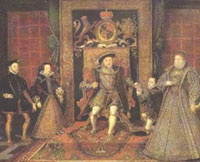 From humble beginnings in the service of the princes of Gwynedd, the Tudor family rose steadily to royal stock.
From humble beginnings in the service of the princes of Gwynedd, the Tudor family rose steadily to royal stock.
The Tudor royal dynasty began with King Henry VI acceding to the throne of England, Wales and Ireland in 1485, and ended with the childless death of Elizabeth I in 1603. They are famed for taking the country from a run-of-the-mill medieval kingdom to the pre-eminent world power on the brink of Empire.
But while Henry VIII and Elizabeth I were noted English monarchs of vast wealth and power, the family had far humbler origins.
The princes of Gwynedd such as Llywelyn ab Iorwerth (Llywelyn The Great) and his sons had in their service an aristocratic family of advisors, diplomats, servants and councillors.
The first of the dynasty of the early 'Tudors' was Cynfrig ab Iorwerth but his son, Ednyfed Fychan, was the one who cemented his family's position in the administration of Gwynedd. He was a diplomat and ambassador, acting for Llywelyn in negotiations with the English crown.
Ednyfed Fychan married Gwenllian, daughter of The Lord Rhys ap Gruffydd of Deheubarth, raising the social stock of his family. Ednyfed had at least six sons, all of whom entered the service of the princes of Gwynedd.
The eldest, Goronwy, took his father's place as 'Seneschal' of Gwynedd - the chief advisor and councillor with legal and diplomatic powers. His son was known as Tudur Hen, sometimes anglicised to Tudor. He was Lord of Penmynydd, a settlement in Anglesey. His position reflected the growing stature of his family.
Tudur Hen's grandson, Tudur Fychan, married Margaret ferch Thomas of the Gwynedd royal family. She was descended from Llywelyn ab Iorwerth on her mother's side and the Plantagenet kings John, Henry III and Edward I on her father's side.
Tudur and Margaret had at least five sons, who were active in the rebellion of their cousin Owain Glyndwr. The youngest, Marededd ap Tudur, had a child called Owain ap Tudur ap Marededd.
Owain was the key to the continued rise of the family. He managed to get round the punitive measures issued against Welshmen in the wake of the Glyndwr insurrection, through following his family's tradition of following prevailing winds.
He is thought to have fought with or assisted King Henry V in his French wars, and become close to the English royal court. After the death of Henry, he married, in secret, the dowager queen Catherine of Valois.
A member of a servile Gwynedd family of proletarian stock had married into a powerful western European royal family.
Source British Broadcasting Corporation
点击查看本频道更多精彩内容